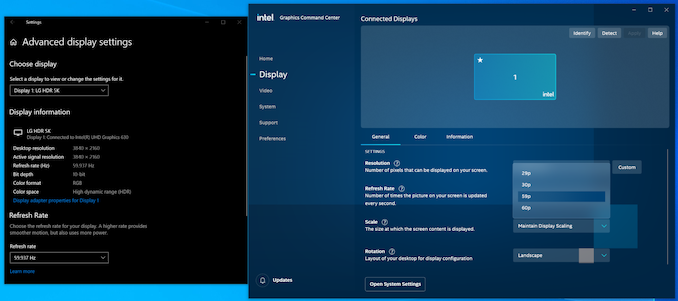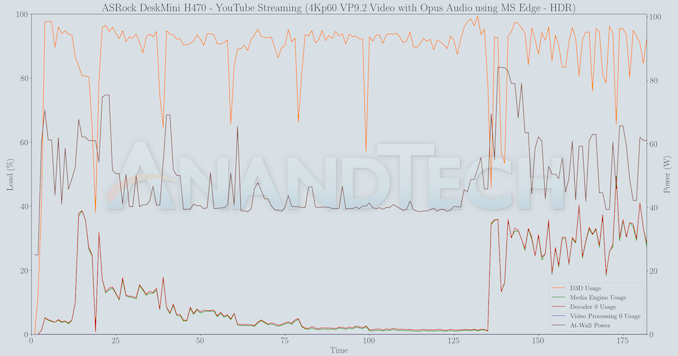ASRock DeskMini H470 Review: A No-Frills LGA 1200 mini-PC Platform
by Ganesh T S on December 29, 2020 8:00 AM ESTHTPC Credentials - Display Outputs and Streaming Capabilities
The ASRock DeskMini H470 comes with four display outputs - A 4Kp30 HDMI 1.4a port, two 4Kp60 DisplayPort outputs (one via a full-sized DP connector, and another via USB-C), and a D-Sub connector supporting up to 2048x1536 at 85 Hz. However, only three of these outputs can be simultaneously active. From a HTPC use-case perspective, the absence of 4Kp60 over HDMI is a dampener, though the DisplayPort outputs are feature-rich enough (full 4Kp60 support with HDR and HDCP 2.2) for HTPC use-cases. Along with SGX support, the DeskMini H470 could theoretically be used to play back protected content such as 4K Netflix streams and UltraHD Blu-rays.
Supporting the display of high-resolution protected video content is a requirement for even a casual HTPC user. In addition, HTPC enthusiasts also want their systems to support refresh rates that either match or be an integral multiple of the frame rate of the video being displayed. Most displays / AVRs are able to transmit the supported refresh rates to the PC using the EDID metadata. In some cases, the desired refresh rate might be missing in the list of supported modes.
Display Resolutions and Refresh Rates
Given the lack of a native HDMI 2.0 port, our evaluation of the ASRock DeskMini H470 as a HTPC was done using the full-sized DisplayPort output connected to a LG 34WK96U-W. The 5K2K LG monitor supports all possible refresh rates of interest - including both NTSC and PAL - with HDR enabled.
Despite the monitor supporting the 23 Hz setting, we were only able to activate selec refresh rates, as shown in the above screenshot.
YouTube Streaming
The move to 4K, and the need to evaluate HDR support have made us choose Mystery Box's Peru 8K HDR 60FPS video as our test sample moving forward. On PCs running Windows, it is recommended that HDR streaming videos be viewed using the Microsoft Edge browser after putting the desktop in HDR mode.
As per specifications, the Core i7-10700 should have no trouble decoding VP9 Profile 2 videos (more on that in the next section). However, for some reason, we had the playback of the 4Kp60 HDR stream from YouTube punctuated by frequent stutters and dropped frames - you can note almost half the frames getting dropped in the statistics section of the above screenshot. In contrast, the non-HDR clip (VP9 codec) played back flawlessly for the same resolution and frame rate.
Various metrics of interest such as GPU usage and at-wall power consumption were recorded for the first four minutes of the playback of the HDR stream. The numbers are graphed below.
The HDR stream regularly pushes up the D3D usage close to 100% - and the result is the dropping of frames in the course of playback. The initial stages have a higher decoder and video processing usage numbers as the overlay is activated. The decoder usage goes up towards the end of the graphing, as the stream finally catches up to 4K after starting off with the 1440p version. While the 1440p HDR stream consumes around 40W at the wall, the move to 4K pushes it to just south of 60W.














26 Comments
View All Comments
Tomatotech - Tuesday, December 29, 2020 - link
That’s possibly one of the best possible arrangements for the m.2 slot then as the metal tray will be an excellent heat sink. You could even add a bit of thermally conductive foam (make sure it’s not the electrically conductive type) to help with heat transfer to the tray.ganeshts - Tuesday, December 29, 2020 - link
The Ultra M.2 slot is on the top side of the board. That is the one used with Comet Lake CPUs. The slot you are referring to is the Hyper M.2 (PCIe 4.0 x4) slot which is usable only when the Rocket Lake CPUs come around.twotwotwo - Tuesday, December 29, 2020 - link
Its AMD relative the A300 was my main machine for a while, and had it been easier to get Zen 2 desktop APUs I might still be using it. Quiet (given a decent fan), cheap, tiny (obvs), reasonably expandable, gets the job done--about all I can ask for from a work desktop.Death666Angel - Tuesday, December 29, 2020 - link
The 4000 Series Pro APUs are pretty well available in Germany, from reputable online retailers. I can get the R5 Pro 4650G for 20% more than the equivalent R5 3600 (200€ vs 240€ roughly). That would be my sweet spot, personally. For 8 cores it's also roughly 20% (280€ vs 340€) but for that price difference, you could get a nice used GPU already that will maybe game better. I personally could never justify a GPU-less build, although I am eternally curious about them and plot one out once every couple of months.... and then I look at benchmarks of dGPU vs iGPU and stop. :DTomatotech - Tuesday, December 29, 2020 - link
I didn’t see it in the article so here are the specs:155 x 155 x 80 mm (1.92L)
Not bad, though for most low to mid-level use cases it’d be far cheaper to buy a used Lenovo or Dell USFF PC - these have even less volume at around 1.1L but are slightly larger and flatter (around 180x180x35mm)
For SFF with GPU I still prefer something like the K39 mITX chassis on the low end which comes in at 3L but allows you to use most full-sized GPUs (but for now possibly not the nVidia 3000 series).
Samus - Tuesday, December 29, 2020 - link
I've been rocking the FT03-Mini and while it is an absolute nightmare to work inside of (and I question my sanity for why I put myself through owning it) it is still a very effective ITX chassis for the size, capable of 10.5" videocards, multiple hard drives (plus two m2 drives you can mount to most current motherboards) while using a single 140mm fan to cool everything. Realistically the highest TDP CPU you want to use is around 88-watts as anything more you will stress any closed loop cooler with a 25mm radiator (the max the case can accept) and need to go to a heatsink of some sort with another dedicated fan.Obrut - Tuesday, December 29, 2020 - link
It will be interesting to see a comparison with ASRock Jupiter H470, which has a much different form factor and cooling solution.M O B - Tuesday, December 29, 2020 - link
I have a Deskmini 310w--is the UHD 630 on 10th gen CPUs any faster than the UHD 630 on older CPUs?If not, then it seems like this iteration basically adds some USB 3.0 ports versus my current build.
ganeshts - Wednesday, December 30, 2020 - link
I think the additional angle here is that of a low-cost platform that can take advantage of the RKL-S CPUs coming in 2021. Personally, I also think it is not a great choice to upgrade for those who already have the 310. It is meant more for folks getting their first mSTX machine.Samus - Tuesday, December 29, 2020 - link
I had the SST-AR11 cooler in my Silverstone FT03-Mini and was pretty disappointed (partially due to the chassis inherently poor ventilation) and equally disappointed by closed-loop coolers due to the 25mm thickness limitation of radiators. After spending seemingly hundreds of dollars and way too much time hunting for a thermal solution, some forum posts directed me to try the NT06-Pro, which would theoretically fit this mSTX chassis as long as there is no interference with the power supply.It performs incredible well as you position the fan under the fins and blow the heat away from the motherboard instead of onto it, giving it somewhat of the beneficial effect of a tower-style cooler.